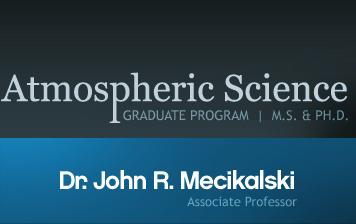Satellite-based Convective Storm & Convective Initiation Studies
1-6 hour Convective Initiation Research
 Background:
Background:
For this aspect of the work done by Dr. Mecikalski’s team, two components are being developed: (a) 0-6 hour CI nowcasting where land-surface heating gradients are responsible for convergent boundary formation, and (b) 0-6 hour CI nowcasting where land surface heterogeneity and elevation are important in dictating where convective updrafts form more frequently.
Main Results
A method (Walker et al. 2009) that identifies locations of land-surface sensible (SH) and latent heating (LH) gradients using GOES and MODIS observations will be implemented to aid in the prediction of CI in the 1-6 hour timeframe. This method employs remotely sensed (MODIS) land surface characteristics of vegetation and soil moisture as well as GOES/SEVIRI-derived insolation to develop a surface “heating index.” In addition to the Walker et al. (2009) approach, we will rely on WRF model-based Land Information System (LIS; Case et al. 2008) fields that map vegetation, soil moisture and topography to ~1 km resolution. LIS, operated in a real-time sense, generates the accompanying heating patterns provided atmospheric forcing. LIS-generated SH and LH, respectively fields are produced daily at UAH in collaboration with the NASA Short-term Prediction Research and Transition (SPoRT) Center. Additionally, the heterogeneity of the land surface will be mapped, specifically, gradients in MODIS NDVI, land-cover type (e.g., forests versus pasture or lakes), as well as elevation gradients. A “land surface variability” (LSV) metric is subsequently formed, which has been positively correlated to locations of enhanced convective cloud frequency of occurrence (Gambill and Mecikalski 2010).
The focus at UAH for 0-6 h CI nowcasting is CI occurring on “synoptically calm” days (Brown and Arnold 1997) when advections are small, henceforth complementing the work of UW-CIMSS and CIRA. The heating (which applies to lands with minimal heterogeneity) and LSV (which alternatively considers land-surface heterogeneity) indices will be used along with the NASA LIS fields to measure 2-6 km resolution heat- and moisture-related gradients that aid in 1-6 hour CI nowcasting. Strong gradients in land surface heating can lead to the development of mesoscale circulations, resembling inland sea breezes and so-called "non-classical mesoscale circulations" (NCMC). Methods will subsequently be developed to objectively identify likely locations for the development of NCMCs due to daytime heating responses to LSV. Maps of 1-6 hour CI probability, highlighting regions near and surrounding NCMCs, will be developed. The heating gradient fields will also be coupled to the GOES-R mesoscale AMV-related fields and near-casting algorithm to specify locations where meso-g (2-25 km) convergences are increased as a result of heating discontinuities. The quantified probabilistic results of this portion of the study will be integrated with the results from CIRA, UW-CIMSS, CREST and NSSL for the formation of the 1-6 hour CI nowcasting system.

